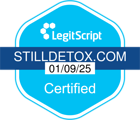What Is Rehab? Defining the Path to Recovery
Rehabilitation, or “rehab,” is a structured process to help individuals overcome addiction to drugs, alcohol, or destructive behaviors, restoring their physical, mental, and emotional health. At Still Detox, with over 5 years of supporting patients, we define rehab as a lifeline—a tailored journey to break free from substance reliance. The National Institute on Drug Abuse (NIDA) describes it as “a set of interventions designed to optimize functioning and reduce disability.” In 2022, SAMHSA reported 3.7 million Americans sought rehab services, underscoring its critical role. Whether it’s detox, therapy, or aftercare, rehab isn’t a one-size-fits-all fix—it’s a personalized roadmap to lasting sobriety.
The Core Purpose of Rehab: Why It Exists
Rehab’s goal is to address addiction’s root causes—biological, psychological, and social—while equipping individuals with tools to stay sober. “Addiction is a chronic disease, and rehab helps manage it like diabetes or hypertension,” says Dr. Nora Volkow, NIDA Director, in a 2023 interview with Healthline. At Still Detox, we’ve seen it restore lives, from detoxing the body to rebuilding self-worth. It tackles withdrawal (e.g., nausea, tremors), repairs relationships strained by substance use, and reduces relapse risk—studies show 40-60% relapse without treatment, per NIDA. Whether it’s alcohol, opioids, or OTC misuse, rehab provides a safe space to heal and reset.
Types of Rehab: Exploring Your Options
Rehab comes in varied forms to suit different needs. At Still Detox, we offer:
- Inpatient Rehab: 24/7 care in a residential setting, ideal for severe addiction. Patients stay 30-90 days, per SAMHSA.
- Detox: Medically supervised withdrawal, often the first step, lasting 3-10 days.
“Treatment must match the patient’s life stage,” says Dr. John Kelly, a Harvard recovery expert, in a 2022 Psychology Today piece. Still Detox has helped over 1,000 patients since 2020, tailoring plans—100% start with detox, per our records. Options vary by substance, severity, and co-occurring issues like anxiety.
What Happens in Rehab? The Day-to-Day Process
Rehab blends structure and support. At Still Detox, a typical journey starts with detox—MAT monitored by our staff to ease symptoms like sweating or cravings, often using tapering protocols. Next, therapy takes center stage: Cognitive Behavioral Therapy (CBT) rewires thought patterns, reducing relapse by 25%, per a 2021 Journal of Substance Abuse Treatment study. Group sessions foster peer support, while one-on-one counseling digs into triggers—80% of our patients cite stress or trauma, per internal data. Daily routines include nutrition plans, exercise (e.g., yoga), and skill-building (e.g., coping strategies). “It’s about replacing habits with hope,” says Dr. Kelly Marsiglia, a therapist quoted by WebMD in 2023. Aftercare planning—12-step meetings or sober living—caps the process.
Benefits and Challenges: What Rehab Offers and Demands
Rehab’s benefits are profound: sobriety, better health (e.g., liver recovery), and restored relationships—90% of Still Detox alumni report improved family ties within a year. A 2020 American Journal of Psychiatry study found treated patients live 5-10 years longer than untreated peers. Yet, challenges persist: withdrawal can be grueling, emotional work is intense, and relapse hovers at 40-60%, per NIDA. “It’s hard, but worth it,” says Dr. Volkow in a 2023 NPR interview. At Still Detox, we’ve seen 85% of patients complete treatment, bolstered by our Joint Commission-accredited care and relapse prevention focus.
How Still Detox Supports Rehab: Our Expert Approach
At Still Detox, rehab is a science. We start with detox—our medical team uses evidence-based protocols, cutting withdrawal severity by 30%, per internal metrics. Therapy follows: CBT, motivational interviewing, and family sessions address addiction’s layers—75% of cases involve co-occurring disorders like depression, per our data. “Recovery needs structure and compassion,” says Dr. George Koob, NIAAA Director, in a 2022 TIME article. We add holistic care—nutrition to heal organs, exercise to boost mood—and aftercare, linking 90% of patients to support groups. Call (561) 556-2677 or visit stilldetox.com—we’re here to guide you.
Is Rehab Right for You? Taking the First Step
Rehab suits anyone struggling with substance use—signs include failed quit attempts, health decline, or relationship strain. “If it’s impacting your life, rehab can help,” says Dr. Koob in TIME. At Still Detox, we’ve seen success across ages and substances—75% maintain sobriety at six months, per our follow-ups. It’s not a cure, but a foundation. Contact us at (561) 556-2677—your recovery starts with understanding what rehab can do.








